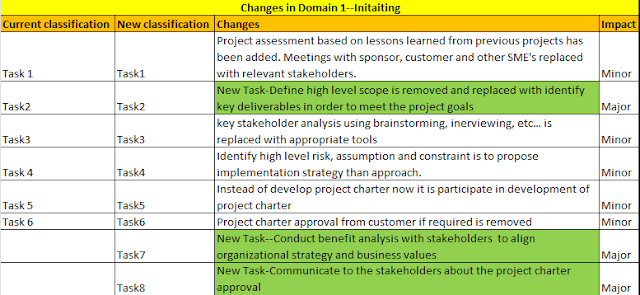
I know many of you must be aspiring to become successful project managers in your career which can be the stepping stone to become good leaders. How you can achieve this? Yes, by implementation which is critical. And to distinguish from others you need to have some kind of credentials which can be obtained through certifications like PMP, ITIL. To know more about or to get prepared for the same, you can always approach me @ bksprasad@yahoo.com or subramanya.bks@gmail.com
Sunday, June 28, 2015
Saturday, June 27, 2015
Work performance data, Work performance information and Work performance reports
Work performance data is the raw date which is being collected as part of measurements. Data is the output of executing. For example Planned Value, Earned Value and Actual Cost are Work performance data.
Work performance information is the processed data which will be the output of every control processes like control schedule, control cost, etc...For example Schedule Variance, Cost Variance are the Work performance information.
Work performance reports is the report which is used for project communication to stakeholders. The stakeholders are interested in reports and not the data. For example dashboard which indicates the status like Red, Green, Amber are the Work performance reports.
This concept has been introduced from Data-Information-Konwledge-Wisdom (DIKW) model. This is part of ITIL(Information technology Infrastructure Library)syllabus.
Friday, June 26, 2015
Control Quality, Validate Scope and their relationship
Control Quality is to check the correctness of the deliverables which is the output of executing. This process is used to check the correctness of the Product. This is like internal testing. One of the technique is Inspection which means Testing, audit, review, walkthrough...If this Inspection is through then we can move towards Validate Scope process.The output of Control Quality process is Verified deliverables.The verified deliverables will be fed as an input to Validate scope process.
Validate scope is formalizing the acceptance of the deliverables. Who is going to accept the deliverable? Yes, Customer. Before calling the Customer we need to check is the deliverable working as per the requirements or not? That is why Control Quality will be performed before Validate Scope process. Validate Scope is something like User Acceptance Testing(UAT). Here too we are having Inspection as one of the techniques. The output of Validate scope is Accepted deliverables. Then we proceed for closing.
Thursday, June 25, 2015
PMP® exam is changing in 2015--Update: The PMP exam update has moved to 11 January 2016 to allow all stakeholders adequate time to prepare for this change.
Domain 1---Initiating the Project
3 tasks added – task 2, task 7, task 8
Domain 2---Planning the Project
1 task added – task 13
Domain 3---Executing the Project
2 tasks added – task 6, task 7
Domain 4---Monitoring and controlling the project
2 tasks added – task 6, task 7
There is no addition of tasks under Closing process group/domain.
Here is the list.
Initiating
# Identify key deliverables based on the business requirements, in order to manage customer expectations and direct the achievement of project goals.
# Conduct benefit analysis with stakeholders (including sponsor, customer, subject matter experts), in order to validate project alignment with organizational strategy and expected business value.
# Inform stakeholders of the approved project charter, in order to ensure common understanding of the key deliverables, milestones, and their roles and responsibilities.
Planning
# Develop the stakeholder management plan by analyzing needs, interests, and potential impact, in order to effectively manage stakeholders' expectations and engage them in project decisions.
Executing
# Manage the flow of information by following the communications plan, in order to keep stakeholders engaged and informed.
# Maintain stakeholder relationships by following the stakeholder management plan, in order to receive continued support and manage expectations.
Monitoring & Controlling
# Capture, analyze, and manage lessons learned using lessons learned management techniques, in order to enable continuous improvement.
# Monitor procurement activities according to the procurement plan, in order to verify compliance with project objectives.
Please refer to the following links to get the details for the information and to find the difference between existing and proposed examination content outline.
http://www.pmi.org/certification/exam-changes/pmp.aspx
http://www.pmi.org/~/media/PDF/Certifications/pmp-certification-exam-outline.ashx
http://www.pmi.org/Certification/Pr...ons/PMP Examination Content Outline_2010.ashx
The following tables provides the change in the percentage of questions in each of the process group and the changes in the exam content outline from the previous one.
This is latest update from PMI. Update: The PMP exam update has moved to 11 January 2016 to allow all stakeholders adequate time to prepare for this change. The current examination content outline remains till 11th Jan 2016 and the new examination content outline published during June 2015 will be effective from 12 Jan 2016.





